Finding and photographing Arizona and Sonoran desert toads and frogs.
Even in four-wheel drive I had trouble keeping my truck on the rain-slicked dirt road. I fought to cross the normally dry desert washes now filled with thick, brown water. Monsoon rains pummeled the ground and forced most wildlife to seek cover.
Only a rare opportunity — such as seeing seven species of desert frogs and toads fighting to procreate in this harsh environment — could take me from the comfort of my house out into a dark and dangerous Sonoran Desert night.

Photo credit: Bruce Taubert
This group of amorous Sonoran Desert toads (Bufo alvarius) represent the largest toads native to the United States. They can weigh more than 2 pounds and reach 8-inch lengths.
Several unique amphibians call Arizona’s Sonoran Desert home. Casque-headed frogs, Sonoran green toads and Sonoran Desert toads are more commonly found in Mexico. Others, such as narrowmouth toads and Great Plains toads, are associated with semitropical or temperate habitats in the United States and Canada. Like all frogs and toads, they developed during the Pleistocene when marsh habitats grown over with huge tropical ferns dominated the landscape. In Arizona this type of environment is mimicked only during the brief summer monsoons.
Life-Giving Rains
Arizona’s monsoons come fast and hard and only last a few weeks. With the sudden rains comes a complete metamorphosis of the desert. Dry washes turn into rivers; concrete-hard, sun-baked soils soften and ephemeral ponds fill with water. Temperatures drop and humidity increases from less than 15 percent in June to 80 percent in the heat of the afternoon during July and early August. And creosote flats turn into lakes.
Wildlife hidden for 10 months or more suddenly appears, including Arizona’s Sonoran Desert frogs and toads. This is also the time of the year when I turn from being a diurnal administrator at the Arizona Game and Fish Department to also being a nocturnal photographer and naturalist.
As soon as strong monsoon thunderstorms begin approaching the southern edges of Maricopa County, I break out the night lights, macro lens and camera, disposable tennis shoes and collecting jars. On the chance that the storms hit my favorite desert amphibian sites, I leave my home at 7:30 p.m. and tell my wife Anne not to wait up for me. After driving almost two hours to my favorite amphibian site, I get there just after dark and in time for what hopefully would be a rewarding night.

Photo credit: Bruce Taubert
The cactus-studded landscape of Arizona’s Sonoran Desert comes alive during brief summer monsoons. This is when several desert frog and toad species emerge from underground burrows to procreate.
The "Desert Seven" Arizona Toads
My quest this year was to find and photograph all seven desert toads and frogs known to breed in this small part of the Sonoran Desert — the only place in the United States where these critters are all found together. I tried, off and on, for the last 15 years, but I never seemed to be there at exactly the right time and place. I’d found all seven, but not in the same year, and I did not have photographs of all of them.
I reached the first set of ponds on the northern edge of my search area. I stopped the truck, turned off the engine and listened. Dead silence! I couldn’t believe the frogs hadn’t arrived. I got out and searched the pond edges for movement. Nothing! I got in the truck and went down the road to look for more possible breeding ponds.
Ancient mesquite trees grew in the high burm surrounding the cattle tank at the next location. The tank, only a puddle a few days earlier, was more than 100 feet across from the rainwater flowing into it. In order to access the tank, I walked several yards from the cattle enclosure and through a thicket of skin-cutting mesquite. While I crawled under a large tree I spotted my first quarry: a Sonoran Desert toad.
Bufo alvarius
The Sonoran Desert toad (Bufo alvarius) weighs in at little more than 2 pounds and is 8 inches long. It is the largest toad native to the United States. I most often find these huge toads lumbering around looking for mates or food. I can imagine that to other frogs and toads in and around the ponds Bufo alvarius (aka the Colorado River toad) must look like a T-rex.
These toads are voracious eaters and consume almost anything they can get into their mouths, including other toads, tarantulas, snakes, scorpions, mice and insects. With six other morsel-sized amphibians in the vicinity, monsoon season must seem like a virtual smorgasbord to a Sonoran Desert toad.
Although I have known Sonoran Desert toads to breed in permanent ponds before the monsoon rains start, they are most active after the first rains in July. They call from the banks of small ponds and grab females as they happen by. When these toads are in full-breeding swing I have seen 10 or more pairs in amplexus and several females carrying bulky males on their backs while looking for water. Compared to other serenading amphibians, Sonoran Desert toads have quiet voices for their size, probably limited by their small vocal sacs.
These toads have huge paratoid glands just behind their eyes and small white “warts” near the corners of their mouths. Their paratoid glands ooze large amounts of white poison when they are disturbed too much. A friend of mine believes that one of his Labrador retrievers died as a result of swallowing one of these toxic critters. Rumor has it that Sonoran Desert toad poison has been used as a strong hallucinogen, so wash your hands after handling one.
Bufo cognatus
At the same pond, I found another early arrival, the Great Plains toad (B. cognatus). This toad is big, brown and not very attractive. Great Plains toads are the second largest amphibian at the ponds (the largest females are 4 inches). They are insectivores and not dangerous to other pond anurans.
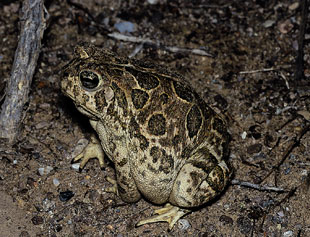
Photo credit: Bruce Taubert
Great Plains toads (Bufo cognatus) have the largest geographical distribution of all the desert toads.
The unmistakable, high-pitched eeeeeeeee of the these toads can be heard for considerable distances, and a single call may last up to one minute or more. Great Plains toads have the largest geographical distribution of all the desert toads. Quite remarkably, they have evolved to live in Alberta, Canada, where the winter temperatures can drop to minus 50 degrees Fahrenheit, and in the water-poor, creosote-bush-dominated desert of Arizona, where temperatures seldom drop below freezing. In the desert ponds, the Great Plains and Sonoran Desert toads are the first in and last out. Both can be found breeding before the first rainfall in June and well into September.
Gastrophryne olivacea
Somewhere in the darkness, I heard the faint call of the western narrowmouth toad (Gastrophryne olivacea). I decided to go look for it, and on the way I almost stepped on a Mojave rattlesnake (Crotalus scutulatus). These rattlesnakes are very venomous and well camouflaged. I promised myself not to come out here alone again! Twenty minutes later, I came upon a pond that I’d never been to before, and low and behold, I found some western narrowmouths.
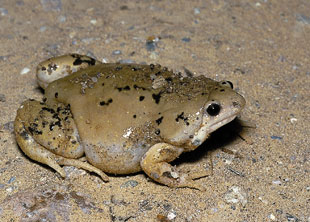
Photo credit: Bruce Taubert
Western narrowmouth toads (Gastrophryne olivacea) don’t display the typical warty skin of most toads, but they still pack a toxic wallop if an unwary predator were to attempt to eat them
Western narrowmouth toads normally appear the first or second night after the first hard rain. These little toads are barely 11/2 inches long and are thought to be limited to eating ants.
Because of their small size and secretive nature, I always have difficulty finding them. To photograph them calling and/or breeding, I slipped into the nasty waters of the ponds (most have copious amounts of cattle feces and urine in them) and waded toward their buzzing calls. By the time I found the calling males, I was waist-deep in a witches’ brew and covered in blood emanating from my many mesquite-spine-inflicted wounds. Unfortunately, I’ve never found narrowmouths in amplexus, and I haven’t been able to photograph them calling, either.
Unlike most toads, the skin of western narrowmouths appears to be moist with no obvious warts. Even though they lack the obvious “equipment” to produce toxins, they are extremely toxic if eaten. Both narrowmouths and spadefoots cause me to react strongly when I handle them. I sneeze and my eyes water. If you don’t wash your hands after picking up this toad, you’re in trouble!
Upon exiting the pond, I removed my tennis shoes, draining them of water and mud. I was frustrated at only having seen three of the seven amphibian species. I ate a granola bar, took a drink of water and started for where I thought I left my truck.
Bufo retiformis
On my way, I saw several Sonoran Desert toads near a large wash, so I decided to walk along it for a while. Several yards from where I saw the Sonoran Desert toads, I spotted my first Sonoran green toad. On the very first night of the monsoon rains, I found male and female Sonoran green toads as far as 100 yards from standing water.
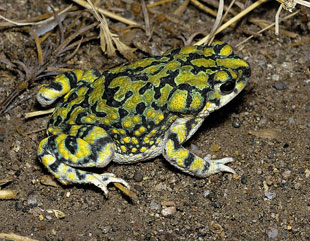
Photo credit: Bruce Taubert
Sonoran green toads (Bufo retiformis, this is a female) are some of the prettiest herps found in the Sonoran Desert.
The Sonoran green toad (Bufo retiformis) is my favorite. These 21/2-inch-long toads occur only in Arizona and Mexico. Within Arizona, the majority of their distribution is on the Tohono O’Odham Indian Reservation, where they are restricted to the lowest elevations, a landscape dominated by creosote and ironwood. The hotter and drier the better for these Arizona endemics.
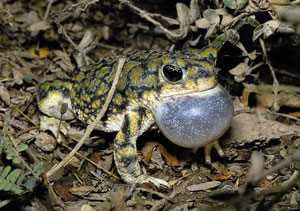
Photo credit: Bruce Taubert
This male Sonoran green toad is calling for a female. These toads will spend as much as 10 months underground while they wait for the summer monsoon rains to arrive.
This little “jewel of the night” seems out of place in drab desert surroundings. Its incredible white, yellow and bright green colors make it the most beautiful animal, other than some birds, that I’ve ever seen. Their call is very similar to that of the narrowmouth toad, a series of short buzzing notes. Like narrowmouth toads, they have small mouths, and I’ve only seen them eat ants (both winged and wingless).
Not frequent breeders at permanent waters, Sonoran green toads appear to prefer ephemeral ponds. Calling from the open or nestled in loose cover near the edges of ponds, males work to attract females. Although this behavior appears to be normal, I have also found males calling from floating debris in ponds. When a responsive female finds a crooning male, he grabs her in amplexus. Next, the normally larger female hops (or drags) the clutching male to the water, where she spends the next few hours depositing eggs while the male fertilizes them.
So ended the first night of my search for the “desert seven.” As I drove toward the highway, I saw more sidewinders, toads, millipedes and several banded geckos.
Second Act
Two nights later, I convinced Randy Babb and Dr. Tom Jones to go afield with me. It really didn’t take much convincing, as both are avid herpers, field biologists and photographers.
The drive to the ponds was noticeably different this time. It had rained significantly over the previous two days, and the road was horrible. Every rut contained standing water, and the washes were thick with gooey mud. Every time we stopped and listened for calls we heard at least two species: mostly Great Plains toads and Sonoran green toads.
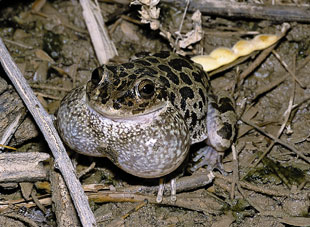
Photo credit: Bruce Taubert
Male northern casque-headed frogs (Pternohyla fodiens) have loud calls and relatively large bilobed vocal sacs
Millipedes were all over the road, making it difficult to keep from running them over. Snakes were also unusually abundant, and I added glossy snakes, California kingsnakes, a diamondback rattlesnake and a gopher snake to the list of snakes from my first night out. We also saw screech owls, one badger, black-tailed and antelope jackrabbits and the odd kangaroo rat. We knew it was going to be a great night when we saw Sonoran Desert and Great Plains toads breeding in the water-filled tire ruts!
Pternohyla fodiens
The first amphibian we heard at our favorite pond (the same one that had nothing going on the first night) was the northern casque-headed frog (Pternohyla fodiens). For me, northern casque-headed frogs are the most difficult of the seven to find. Found only in a small area in Arizona, these 21/2-inch frogs are more closely related to the hylid treefrogs found in the Midwest than any of the other desert-pond inhabitants. Males have loud calls and relatively large bilobed vocal sacs. Their heads are somewhat flattened and presumed to be adapted to burrowing (hence the old name of burrowing treefrog).
Casque-headed males take up a calling station either right at water’s edge, in bushes close to a pond or on floating material in the pond itself. Unfortunately, we were not able to observe these frogs breeding. Both Randy and Tom have spent a lot more time in the field than I have and rarely find casque-headed frogs in amplexus. After an hour of rolling around in the mud taking photographs of the calling males, we decided to look for what should have been the easiest toad to find: the Couch’s spadefoot toad (Scaphiopus couchii).
Back in the truck, we drove, or should I say slid, to the pond I visited two nights earlier. Upon arrival I set off looking for my last two toad species while Randy and Tom began photographing tiger beetles and giant hairy scorpions. I had a love-hate relationship with this pond. The experience of finding lots of frogs and toads was somewhat dulled by the smell of cattle excrement and the huge mesquite tree thorns. I was not sure how or if I missed them the first night, but as soon as I reached the pond this time I saw Couch’s spadefoot toads everywhere.
Scaphiopus couchii
Although common, Couch’s spadefoot toads are no less unique than any of the other desert frogs and toads. They are amazingly adapted to the Sonoran Desert and the brief monsoon seasons. Apparently, these toads can hear the first rains as they beat against the dry desert ground. This awakens them, and they start to dig to the surface and immediately look for water in which to breed.
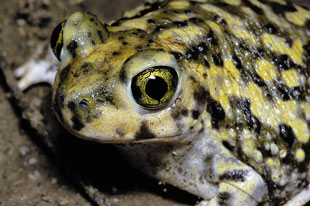
Photo credit: Bruce Taubert
Couch’s spadefoot toads (Scaphiopus couchii) can go from egg to a toadlet capable of living on land in as little as nine days.
After fertilization, spadefoot eggs take just 15 hours to hatch. Tadpoles can develop into toads and are capable of leaving the ponds after an average of 12 days (sometimes as soon as nine days). No other frog or toad in the Sonoran Desert develops as fast, clearly giving spadefoots an adaptive advantage. Their color varies from a drab, olive-green to an attractive light yellow or bright green. I find the eyes of spadefoot toads especially intriguing. They are large and colorful, and the irises seem to be crisscrossed with fissures.
Bufo punctatus
From the other side of the pond I heard, “Hey, Taubert! Get over here and see this stinking red-spotted toad.” Randy always did have a way with words. The 3-inch-long red-spotted toad (Bufo punctatus) is not a common or a regular visitor to these creosote desert ponds, but are more often found in desert riparian areas where rocks and crevices provide places for them to hide from predators.
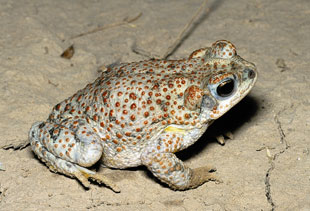
Photo credit: Bruce Taubert
Red-spotted toads (Bufo punctatus) are not common at ephemeral desert ponds, but rather choose to reside in desert riparian areas where water is more readily available.
The red spots covering their bodies and the rounded paratoid glands behind each eye help distinguish them from other toads.
Red-spotted toads also stand out, because they are the only toads found in Arizona that lay single or short strands of eggs. In contrast to the speed with which Couch’s spadefoot eggs develop, it takes red-spotted eggs up to eight weeks to hatch and become toadlets. This is probably why they are less common in this part of the desert, as rainwater is seldom available for as long as eight weeks.
I was done. I found the desert seven!
The three of us wandered around the desert for another hour or two, taking photos of whatever other nocturnal Sonoran Desert creatures crossed our path. We wondered at the diversity of this place and pledged to come back in a couple of weeks, when the little frogs and toads would begin to emerge from these desert ponds.
Future Generations
For Sonoran Desert frogs and toads the monsoon season is one of organized chaos. Because these anurans must breed, feed and grow before the monsoon season ends, gluttony becomes the order of the day immediately after surfacing. Although unusual, I have seen as many as six of the “desert seven” at a single pond in one evening. This order of business repeats itself, on and off during the monsoon season, until either breeding subsides or the ponds become dry.
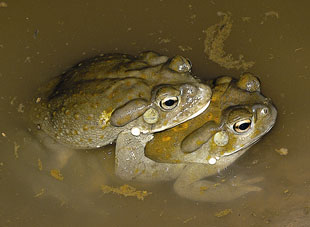
Photo credit: Bruce Taubert
Desert frogs and toads may skip a breeding year if it is an especially dry one, and remain underground until conditions become more favorable. Pictured is a pair of Sonoran Desert toads (Bufo alvarius) in amplexus
Ponds often dry up before eggs can hatch or tadpoles develop into frogs capable of surviving on land, so the eggs or tadpoles simply die. If the monsoon season is short or not very wet, it is likely that there are few successful breedings and the species must wait until the next monsoon to replenish their numbers.
In wet years, these K-selective species (those characterized by slow growth, low fecundity and lengthy lives with multiple reproductive events throughout their lives) produce thousands of toadlets at each pond, many more than are needed to sustain the population. In dry years, many of these species never surface and must wait another year until the next monsoon season for the chance to leave their underground existence.
Depending on the duration of the monsoon season, the “free time” that these frogs and toads of the desert have above ground can last from days to, in a wet year, two months. However, by the end of September all of them are safely tucked away in their underground sanctuaries, waiting for the next monsoon rains before they emerge again to start another cycle of life.
The frogs and toads of the Sonoran Desert are truly as much a part of the monsoon as the rain itself.

